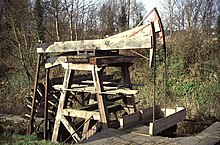| Richard Blakemore | |
|---|---|
 Melingriffith Tin Plate Works (pump pictured) was owned by Blakemore. Melingriffith Tin Plate Works (pump pictured) was owned by Blakemore. | |
| Born | (1775-08-08)8 August 1775 Darlaston, Stafford |
| Died | 17 April 1855(1855-04-17) (aged 79) |
| Nationality | English |
| Occupation(s) | Ironmaster and politician |
| Known for | Held seats in southern Wales at The Leys, near Monmouth, and Velindre House, in Whitchurch, Cardiff |
Richard Blakemore (8 August 1775 – 17 April 1855), MP was an ironmaster and politician. Born in the West Midlands region of England, he held seats in southern Wales at The Leys, near Monmouth, and Velindre House, in Whitchurch, Cardiff.
Career
Through his uncle, the ironmaster John Partridge, Blakemore became a partner with Harford, Partridge and Company, a notable ironmaster firm in South Wales. He assumed management of the Melingriffith Tin Plate Works in Whitchurch at the end of the 18th century. Eventually, he became sole owner of the works, and was directing its management as late as 1838. He also owned the Pentyrch ironworks. He was a contemporary of the ironmasters Richard Crawshay and Richard Hill.
Blakemore was a magistrate for the counties of Glamorgan, Hereford, Monmouth, and Somerset. He served as a Deputy Lieutenant of Monmouth, Glamorgan, and Hereford. A Conservative, Blakemore represented Wells as a Member of Parliament; he was also the High Sheriff of Glamorgan (1826) and High Sheriff of Herefordshire (1830).
Personal life
Blakemore was born in Darlaston, Stafford, England in 1775. He was the elder son of Thomas Blakemore (d. 1808), of Littleton Hall, West Bromwich and Darlaston. His mother was Anne (d. 1838), daughter of ironmaster John Partridge (1704–1791), of Ross-on-Wye. His mother's three brothers, John (1732–1810), Richard (1736–1778), and William (1739–1820), were all ironmasters; John, of Harford, Partridge and Company, assisted most in Blakemore's ironmaster career. His sister Ann married Rev. Luke Booker, vicar of Dudley, and an author of poetry and other publications. Mary, Esther, and Jane were the other sisters.
Blakemore held seats at The Leys and Velindre House. His other holdings included the Hadnock estate, purchased in 1822, after which he demolished the original house, and used the materials to rebuild and extend The Leys property on the other side of the River Wye. He constructed a trestle-work iron tower, 70 feet (21 m) high, as an observatory at the deer park of The Doward, Whitchurch.
Unmarried, Blakemore adopted his nephew, Thomas William Booker, and raised him at Melingriffith Tin Plate Works. Blakemore is buried at the family tombs located at All Hallows Church, Whitchurch. He was survived by his nephew, T. W. Booker, who added Blakemore to his surname, took over the management of Melingriffith, and became Member of Parliament for Herefordshire.
References
- Institution of Mechanical Engineers (Great Britain) (1906). Proceedings – Institution of Mechanical Engineers (Public domain ed.). Published for the Institution by Mechanical Engineering Publications Ltd. p. 602.
- Burke, Sir Bernard (1852). A genealogical and heraldic dictionary of the landed gentry of Great Britain & Ireland for 1852 (Public domain ed.). Colburn and Company. pp. 106, 107–.
- Burke, John (1847). Burke's genealogical and heraldic history of the landed gentry (Public domain ed.). H. Colburn. p. 1008.
- The Gentleman's magazine (Public domain ed.). F. Jefferies. 1855. p. 100.
- Notes and queries (Public domain ed.). Oxford University Press. 1868. p. 415.
- Burke, John (1838). A genealogical and heraldic history of the commoners of Great Britain and Ireland enjoying territorial possessions or high official rank: but uninvested with heritable honours (Public domain ed.). Colburn. p. 52.
- Willett, Mark (1825). The Stranger in Monmouthsire, and South Wales; or, Illustrative sketches of the history, antiquities, and scenery, of South Wales, and its borders (Public domain ed.). p. 3.
- Duncumb, John; Cooke, William Henry; Watkins, Morgan George; John Hobson Matthews (1913). Collections Towards the History and Antiquities of the County of Hereford: . Hundred of Wormelow (lower division), part 1-2 (Public domain ed.). E.G. Wright. p. 17.
- Institution of Civil Engineers (Great Britain) (1859). Minutes of proceedings of the Institution of Civil Engineers (Public domain ed.). The Institution. p. 202.
- Wilkins, Charles (1903). The history of the iron, steel, tinplate and ... other trades of Wales: with descriptive sketches of the land and the people during the great industrial era under review (Public domain ed.). Joseph Williams. p. 244.
- Lloyd, John (1906). The early history of the old South Wales iron works (1760 to 1840) (Public domain ed.). The Bedford Press. p. 107.